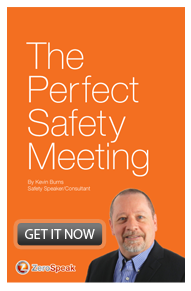Declare War On Safety Apathy
When you don’t ask your people to do anything with the information you are giving them, you are creating the same safety apathy you say you want to overcome.

Are you asking your safety meeting attendees to be participants or spectators? Just because the bodies show up at the safety meeting doesn’t mean that their minds do. They might look like they’re paying attention, but you really can’t tell. It must be OK. You’re not asking them to do anything except sit there.
When you don’t ask your people to do anything with the information you are giving them, you are creating the same safety apathy you say you want to overcome. So ask yourself what specifically would you like your people to do at the safety meeting? How would you like them to engage and participate? What would you like them to do with the information from the safety meeting?
When Length Of Presentation Matters More Than Content
Safety meetings throw too much information at workers at any one time because safety meetings are more concerned with time than content. Give a presenter a 60-90 minute time-slot to present, and the presenter will over-prepare. In addition to the 10-minutes of really solid information on the subject, the presenter will pad the presentation full of photos from the Internet, YouTube videos, cartoons or funny safety posters. Ten minutes gets stretched into 90 minutes. And this is repeated 4 or 5 more times over the course of the day.
It’s a shame when scheduling of presentations becomes more important than the subject-matter in the presentation: filling the time-slot becomes more important than filling minds.
Too Many Words To Make A Point
On average, presenters speak 150 words per minute. Over a 90-minute presentation, that’s 13,500 words used. Most presentations can be summarized in 10 minutes - or 1500 words. That means 12,000 more words were used than needed. Multiply that times another 4 presentations and you have 67,500 words that your people have to extract the 7500 most meaningful and memorable words. 7500 words is a lot to remember - especially when distracted by 60,000 unimportant words.
Give too much information or take too long between relevant points (with useless verbiage) and people will disengage while they try to figure out what the important stuff was. If you don’t ask them to write anything down, you are ensuring that they disengage from safety.
A Lot Of Money Spent To Have Nothing Done
It should embarrass any safety manager to walk into a safety meeting at a professional conference center where thousands of dollars have been spent on the conference center meeting room (see my post Why Safety Meetings Must Move Out Of Back Shops), the Audio-Visual equipment, the sound system, staging and lighting, catering of lunches, coffee and snacks and not to mention the presenters who have invested hours into pulling together high-quality learning sessions. But then, no one bothered to put any paper or pens on the tables for people to take notes. Attendees are not encouraged to remember anything from the day that has cost in the tens of thousands of dollars to organize and execute.
They don’t have to ask or answer any questions. They don’t have to take notes or be able to recall anything they learned. All they are required to do is to sit quietly, drink their coffees and eat their lunches and maybe occasionally give a smattering of applause. If you don’t ask your people to write anything down, to commit it to memory through the process of note-taking, they won’t remember it. It will be business as usual tomorrow.
Why Take Notes?
Taking notes aids comprehension and retention. Researchers (Howe, 1970) found that if important information was contained in notes, it still only had a 34% chance of being remembered. Information not found in notes had a dismal 5% chance of being remembered. People who don’t take notes, forget 95% of what they are told.
When you don't ask your people to take notes, you send a message that none of it is worth remembering. You are wasting the presenters’ time as well as the workers’ time. You organized all of it for nothing.
Toolbox, tailgate, stand-down, safety day or safety awards banquet, all must have a purpose and a reason. You must ask them to write down what was talked about, what was presented. Do not allow anyone to skate through the safety meetings without being engaged. Something as simple as paper and pens on every table and every once in while saying, “I want you to write this down” engages. Ask them to take notes. They will.
Safety apathy stops when you ask your people to engage.
I've been speaking at meetings big and small for fifteen years. Why not lean on what I've learned over that time to help you engage your people in safety at your next safety meeting?



